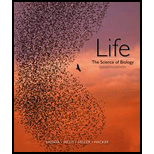
Life: The Science of Biology
11th Edition
ISBN: 9781319010164
Author: David E. Sadava, David M. Hillis, H. Craig Heller, Sally D. Hacker
Publisher: W. H. Freeman
expand_more
expand_more
format_list_bulleted
Concept explainers
Question
Chapter 22.1, Problem 2R
Summary Introduction
To review:
The factors that make the reproductive isolation an essential component of each concept of the
Introduction:
Reproductive isolation is the most important factors in the divergence of the sexually reproducing lineages. It is a state where the two groups of organisms are not allowed to mate and reproduce new organisms and so, the exchange of the genes cannot take place between them anymore.
Expert Solution & Answer
Trending nowThis is a popular solution!

Students have asked these similar questions
(A) 25
20
20
15
NPP (Mg C/ha/yr)
10
10
5
0
0
2,000
4,000
6,000
ECOLOGY 4e, Figure 20.11 (Part 1)
2017 Sinauer Associates, Inc.
Average annual precipitation (mm)
8,000
explain the cascade of events (starting with relaxing trade winds) that occurs during El Niño in the eastern Pacific (off the coasts of California/North America and Peru/South America) and which lead to food-chain collapse
- start with changes in the physical/oceanographic conditions, andthen systematically describe the cascading effects at each level of the food chain
-
3) Which statement(s) about the Pacific Decadal Oscillation (PDO) is/are TRUE? CIRCLE ALL
THAT APPLY.
A. It is a major driver of salmon populations in the Pacific
B. It affects sea surface temperatures in the eastern Pacific
C. Its cycles typically do not last as long as those of ENSO
D. Evidence that it has occurred over many centuries has been gathered from tree
ring data
Chapter 22 Solutions
Life: The Science of Biology
Knowledge Booster
Learn more about
Need a deep-dive on the concept behind this application? Look no further. Learn more about this topic, biology and related others by exploring similar questions and additional content below.Similar questions
- 4.arrow_forward2arrow_forward1. 2. 3. Marine fish cells are hypotonic compared to their seawater environment; their cells lose water by osmosis and gain solutes. If you add heterotrophic respiration and autotrophic respiration together and then subtract that value from gross primary productivity, then you have a more refined estimate of ecosystem carbon storage than NEE. Differential heating due to the earth's tilt generates the global wind AND oceanic circulation patternsarrow_forward
- KD 200- 116- 66- Vec ATF6 (670) ATF6 (402) ATF6 (373) ATF6 (366) I I 45- 1 2 3 4 5 ATFG (360) (e/c) 9V ATFG (402) g ant- ATF anti-KDEL DAPI barrow_forwardWestern blot results: what information can you get? Presence of proteins of your interest Levels of protein expression Levels of protein activation (must use activation state-specific antibody) Decreased function of the ATM kinase in aging mice. A C57BL/6 female 6 month Con IR 20 month C57BL/6 male 6 month 28 month Con IR Con IR Con IR p-ATM (S1981) ATM P-p53 (ser18) Actinarrow_forwardDoes it show the level of proteins? What about the amount? Levels of protein activation? How can you tell? Does the thickness tell you anything? What about the number of the lines?arrow_forward
arrow_back_ios
SEE MORE QUESTIONS
arrow_forward_ios
Recommended textbooks for you
 Biology: The Dynamic Science (MindTap Course List)BiologyISBN:9781305389892Author:Peter J. Russell, Paul E. Hertz, Beverly McMillanPublisher:Cengage Learning
Biology: The Dynamic Science (MindTap Course List)BiologyISBN:9781305389892Author:Peter J. Russell, Paul E. Hertz, Beverly McMillanPublisher:Cengage Learning Biology (MindTap Course List)BiologyISBN:9781337392938Author:Eldra Solomon, Charles Martin, Diana W. Martin, Linda R. BergPublisher:Cengage Learning
Biology (MindTap Course List)BiologyISBN:9781337392938Author:Eldra Solomon, Charles Martin, Diana W. Martin, Linda R. BergPublisher:Cengage Learning Human Heredity: Principles and Issues (MindTap Co...BiologyISBN:9781305251052Author:Michael CummingsPublisher:Cengage Learning
Human Heredity: Principles and Issues (MindTap Co...BiologyISBN:9781305251052Author:Michael CummingsPublisher:Cengage Learning Concepts of BiologyBiologyISBN:9781938168116Author:Samantha Fowler, Rebecca Roush, James WisePublisher:OpenStax College
Concepts of BiologyBiologyISBN:9781938168116Author:Samantha Fowler, Rebecca Roush, James WisePublisher:OpenStax College
 Biology 2eBiologyISBN:9781947172517Author:Matthew Douglas, Jung Choi, Mary Ann ClarkPublisher:OpenStax
Biology 2eBiologyISBN:9781947172517Author:Matthew Douglas, Jung Choi, Mary Ann ClarkPublisher:OpenStax

Biology: The Dynamic Science (MindTap Course List)
Biology
ISBN:9781305389892
Author:Peter J. Russell, Paul E. Hertz, Beverly McMillan
Publisher:Cengage Learning

Biology (MindTap Course List)
Biology
ISBN:9781337392938
Author:Eldra Solomon, Charles Martin, Diana W. Martin, Linda R. Berg
Publisher:Cengage Learning

Human Heredity: Principles and Issues (MindTap Co...
Biology
ISBN:9781305251052
Author:Michael Cummings
Publisher:Cengage Learning

Concepts of Biology
Biology
ISBN:9781938168116
Author:Samantha Fowler, Rebecca Roush, James Wise
Publisher:OpenStax College


Biology 2e
Biology
ISBN:9781947172517
Author:Matthew Douglas, Jung Choi, Mary Ann Clark
Publisher:OpenStax
Mechanisms of Genetic Change or Evolution; Author: Scientist Cindy;https://www.youtube.com/watch?v=5FE8WvGzS4Q;License: Standard Youtube License